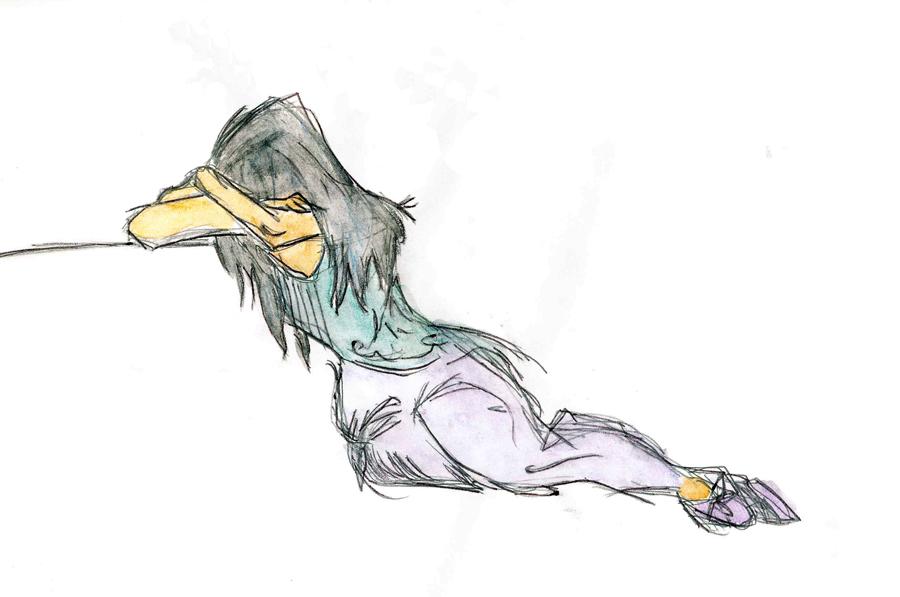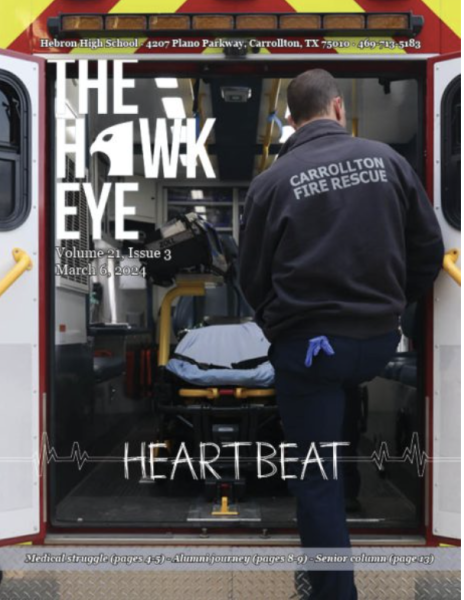False connotations and hidden struggles
Anxiety among students isn’t as uncommon as you may think
March 24, 2014
[vc_row][vc_column width=”1/1″][vc_column_text]
On the first day of physics class this semester my teacher wanted to get to know us by having us answer a few choice questions from a blog. Submit. I leaned back and thought about my responses, wondering if he would read any of them aloud.
The next day he read them aloud. The first question: If you had to explain to an alien, what earth and the human race was like, what would you say? My teacher read our responses aloud and anonymously, the pronouncements of life on earth stood still in the air. At least half said something like “Go back. You’ve come to a place that’s barren and heartless.” I imagined a smidgen of an alien, green-skinned and glossy- eyed, blinking slowly up at the advice of a Hebron student. “This is not somewhere you can be happy. Go home.”
This was probably supposed to be a comical finale to an otherwise simple get-to-know-you activity, but after hearing the responses from my classmates, a fact already known to me became abundantly clear: There are a lot of people having a really hard time. And whether you choose to take these answers seriously or not is your peragative. But I am choosing to believe that something is actually wrong, partly because I feel like no one ever has before, and partly because I feel like no one believed me. I didn’t believe me. I told myself to be quiet and hide and I told myself to smile about it.
We’re told that these sentiments aren’t real. There’s some melodramatic syndrome that somehow infects teenagers. Blame it on the hormones. (The awkward write off that invalidates anything you could be feeling and makes it into something uncomfortable but also normal and OK.) Some feelings shouldn’t be normal. There’s a multitude of things in this world that aren’t OK. Maybe we’re not all just being dramatic.
Yes, there are people who blow things out of proportion and don’t seem to have a real keen gauge as to what qualifies disaster. But we can’t let those people be the standardized norm by which everyone is judged. Because there are people who think they’re crazy or broken. But they’re not.
I heard about the antics of teenagers long before I ever became one. And of course it was painted through one set of brushes. An image I was sure I’d never be associated with. An image in the front of my mind in sixth grade when I read one too many student published poems and vowed to never write of black sticky tears. Because what I had been told, all the clichés and anecdotes about the kind of people who write of those topics weren’t OK. And no one ever said why. To this day it seems to have remained an unmentionable topic for everyone around me, and it’s seemed to stick even after other taboos have lost their tackiness and peel away into conversations.
It’s a taboo to talk of mental illness, therapy sessions and medication. Which, granted, could be because dealing with those is a very personal thing. But it’s also a muddy blotch on cultures everywhere, that jokes about them, or hides them away. It’s a stigma: out of sight and out of mind.
Maybe you never considered it, because no one ever told you how it feels. Maybe you don’t even notice how much you’ve been feeling until someone points it out. So I looked to statistics to grasp the true magnitude of this problem. But polls can’t tell us everything by any means, because suffering goes unmarked. There’s a hushed epidemic of dejection that no poll could really grasp the true numbers of. There are more people who feel the way you do, you just don’t see it. And those people don’t see it in you.
If approached logically, the chances of feeling something completely unique is honestly unfathomable. Because we share more than 99 percent of our DNA, there’s really nothing you could throw around that people haven’t heard before. And these “crazy” thoughts don’t come from just a certain type of person. They’re from people exactly like you and not like you, but you can’t expect to know who is suffering and from what just by guessing or looking.
But a person can be falling apart. Choking in panic. Numb. Listening to a drum, and hearing noise, instead of beats. And all the world sees is a teenager with an attitude issue. Someone bored or inept. For some it can feel like they don’t see anything at all.
Acknowledging you have a problem isn’t the same as acknowledging that you are a problem. There will never be one aspect of life, be it activities, test scores, physical appearance or struggles that could possibly define you. You are a whole person with a lot of dimensions and layers. Sadness or anger or confusion doesn’t have to be your identity. Research, write and ask for help. Make room for other things, because you can be other things.
People think depression is feeling sad. This isn’t necessarily accurate. Depression can be a lot of things, like a lack of feeling. As I sat through my classes week after week I finally realized what I felt like was inside me: static. A buzzing, whiny nonsense noise that drowned out any chance for me to hear anything else. A fuzzy, suffocating Saran Wrap that left me feeling nothing. Not even cold.
There was all this dust. A film of it coating everything, and I could imagine a single, cool breath that would blow it all away. But that never happened.
There doesn’t always have to be a reason for all these feelings. There are various papers from September to December, back of progress reports, semi-expensive cardstock, and a 6-inch gold striped notebook from Target. All ornamented with chicken scratch, with teeny, even cursive, questions. Little voices from various days, like whispers. Asking. “Why? Why did I feel this way? What happened? What was going on?” I couldn’t come up with a single answer. So, whether or not you can come up with a reason, or whether or not you think your reason is good enough, is beside the point. Because the pain is real.
Eventually I started making myself sad on purpose. I’d write sad and listen to sad, and let it drip off of my finger tips and stain everything I wrote. And really, that was what got me breathing again. Because I finally felt something.
Maybe we’ll all look back and realize how crazy we were. Laugh about the tears from all the pressure. But maybe that won’t be looking back. That might be forgetting. Forgetting just exactly what it felt like. And I suppose forgetting will be a good thing. I hope you remember. Remember today, in this moment, that anything you are feeling is real. It’s as real as the 24 or so symbols that made up this column. But it’s more than that. The reality of this world is that everything outside of you can be measured. The number of hairs on your head. The distance from where you are right now, to where you will be in an hour. The number of planets in our galaxy. But everything inside of you, that’s infinite. The ideas and threads of words that create thought. There’s no measure to anything inside your head. You’re more than that.
Sometimes changing external things can help, sometimes you have to do more than alter the measurable. Sometimes you have to make a decision about what you are going to do. That will include a little effort. The point isn’t to stop feeling sad. The point is to move on to other things when it’s time to move. And that can include seeking help. Whatever you decide, know this: What’s inside doesn’t have to be so filled to the rim all the time. You are more than what’s happening right now. You deserve more.[/vc_column_text][/vc_column][/vc_row]







Ambar Chagani • Apr 6, 2014 at 1:29 PM
Great Job! Loved your story and your art work
Ridah Syed • Mar 26, 2014 at 12:30 PM
Caryn, you are such an amazing writer. This was absolutely beautiful. You really were able to capture the point that many people don’t understand about these problems, and you were still able to capture the hopefulness at the end as well. Great job!